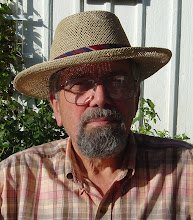Bas-relief carving consists of three processes – chopping in, grounding
out and modelling. Firstly, chopping in consists of making vertical
cuts to outline the edges of the motif, in this case an acanthus leaf, using
carving gouges of appropriate width and curvature (called ‘sweep’) to match the penciled guidelines drawn on the wood. Ideally, this does take a large number
of different gouges. When you’re
starting out and haven’t yet built up a collection, you will have to modify the
drawn outline to accommodate the tools you have. Grounding out is cutting out the wood outside the chopping-in cuts so that the shape
to be modelled stands above a floor, or ground. I have shown this stage in the
top photo above.The last stage, modelling, is the detailing by shaping the petals, leaves, ribbons or
whatever to render the work into three dimensions in a lifelike way. Frequently, that will involve further
chopping-in between parts of the design as you go along to separate the various
components. When carving, pay
close attention to the way the grain of the wood runs, because it is very easy
for splitting to occur in all stages of the process. Some species of wood are more prone to this
than others. This brings me to an
important point. When working in any medium, sharpness of tools
is key, but when woodcarving it is absolutely paramount; the gouges should be
kept razor sharp all the time.
 I make it
a habit at the beginning of each carving session to check each tool for
sharpness as its turn comes to be used. In almost all cases I’ll give that
gouge a few licks on the whetstone before putting it into use. Getting back to the
modelling: after shaping the work as finely as possible with the gouges there
is still work to be done, now by rifflers, possibly sandpaper,and finally
perhaps by burnishing.I don’t like
using sandpaper when carving, it’s just too easy to wear away detail and lose
the crispness that marks a good work; but there will usually be a need for it
somewhere.
I make it
a habit at the beginning of each carving session to check each tool for
sharpness as its turn comes to be used. In almost all cases I’ll give that
gouge a few licks on the whetstone before putting it into use. Getting back to the
modelling: after shaping the work as finely as possible with the gouges there
is still work to be done, now by rifflers, possibly sandpaper,and finally
perhaps by burnishing.I don’t like
using sandpaper when carving, it’s just too easy to wear away detail and lose
the crispness that marks a good work; but there will usually be a need for it
somewhere. For burnishing I have made a handful of small sticks, about pencil
size, out of both hardwood and bone. I like using ash wood for this, and
leg bones left over from a roast of lamb.
The business ends of these handy little tools may be shaped to be pointed
or rounded, flat or curved, concave or convex. When rubbed over the carving it
comes up to a high polish which sets the whole thing off beautifully.Lastly, the matter of
tidying up the ground must be considered. By nature of it being recessed, it is
sometimes difficult to attain a perfectly flat and smooth surface into every
little crevice. For this reason the ground is sometimes treated with punches. Commonly, these punches have waffle-patterned ends. They are not as easy to
find as in the past, but you can make them yourself by filing or grinding a pattern
into the end of a short length of tool steel or an old punch.
For burnishing I have made a handful of small sticks, about pencil
size, out of both hardwood and bone. I like using ash wood for this, and
leg bones left over from a roast of lamb.
The business ends of these handy little tools may be shaped to be pointed
or rounded, flat or curved, concave or convex. When rubbed over the carving it
comes up to a high polish which sets the whole thing off beautifully.Lastly, the matter of
tidying up the ground must be considered. By nature of it being recessed, it is
sometimes difficult to attain a perfectly flat and smooth surface into every
little crevice. For this reason the ground is sometimes treated with punches. Commonly, these punches have waffle-patterned ends. They are not as easy to
find as in the past, but you can make them yourself by filing or grinding a pattern
into the end of a short length of tool steel or an old punch.





No comments:
Post a Comment